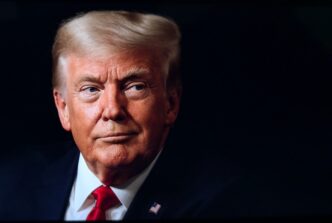Executive Summary
- Federal Reserve Chair Jerome Powell indicated a potential interest rate reduction soon, citing “significant uncertainty” stemming from President Trump’s economic policies and signs of a weakening job market.
- Financial markets largely interpreted Powell’s speech as increasing the likelihood of an interest rate cut in September, with the CME FedWatch algorithm showing an 89.2 percent chance.
- The Fed is navigating a complex economic environment, balancing upside risks to inflation from Trump’s tariffs with downside risks to employment due to a softening labor market and immigration policies.
The Story So Far
- Federal Reserve Chair Jerome Powell is considering interest rate cuts due to “significant uncertainty” stemming from President Trump’s economic policies, including tariffs, immigration restrictions, and tax cuts, which have created a complex environment marked by both rising inflation and a softening labor market. This assessment comes amidst persistent public pressure from President Trump to lower interest rates.
Why This Matters
- President Trump’s economic policies, including tariffs and immigration restrictions, are creating significant uncertainty for the Federal Reserve, directly influencing the likelihood of upcoming interest rate cuts. This policy-induced ambiguity is forcing the Fed to navigate a complex environment of potential inflation and a weakening labor market, leading financial markets to anticipate a September rate cut and respond with rallies in stocks and lower bond yields. The long-term economic impact of these policies remains unclear, posing ongoing challenges for monetary policy and potentially affecting consumer prices and employment.
Who Thinks What?
- Federal Reserve Chair Jerome Powell indicated that the central bank might soon reduce interest rates due to “significant uncertainty” from President Trump’s economic policies and a weakening job market, despite some inflationary pressures.
- Financial markets and analysts interpreted Powell’s speech as strongly increasing the likelihood of an interest rate cut in September, leading to positive market reactions.
- President Trump and some members of the Federal Open Market Committee (FOMC) have advocated for substantial interest rate cuts, with some FOMC members already voting against maintaining steady rates.
Federal Reserve Chair Jerome Powell indicated on Friday that the central bank might soon reduce interest rates, citing “significant uncertainty” stemming from President Trump’s economic policies. Speaking at the Fed’s annual summit in Jackson Hole, Wyoming, Powell highlighted the need to assess whether the impacts of Trump’s tariffs, immigration restrictions, and tax cuts are temporary or indicative of permanent shifts in the U.S. economy, especially as the job market shows signs of weakening.
Policy Uncertainty and Economic Impact
Powell stated that the Fed must determine the lasting effects of President Trump’s policies, including tariffs, immigration restrictions, and tax cuts. “There is significant uncertainty about where all of these policies will eventually settle and what their lasting effects on the economy will be,” Powell remarked, underscoring the complex environment facing monetary policymakers.
The central bank is navigating two opposing economic trends: an uptick in inflation, which typically suggests higher interest rates, and a softening labor market, which would support rate cuts. Powell described this as a “challenging situation,” noting that “risks to inflation are tilted to the upside, and risks to employment to the downside.”
Regarding Trump’s tariffs, Powell acknowledged their “clearly visible” effects but noted it remains unclear if they will result in a one-time price increase or trigger a more prolonged surge in inflation. He added that the full impact is expected to “accumulate over coming months, with high uncertainty about timing and amounts.”
Market Reaction and Rate Cut Expectations
Financial markets largely interpreted Powell’s speech as increasing the likelihood of an interest rate cut in September. The CME FedWatch algorithm, which tracks market expectations, showed an 89.2 percent chance of a rate cut next month, up from 75 percent prior to the speech.
The stock market reacted positively, with the Dow Jones Industrial Average rising 1.8 percent, the S&P 500 index up 1.5 percent, and the Nasdaq gaining 1.8 percent shortly after Powell’s remarks. Treasury yields also responded, with the 10-year yield dropping from 4.31 percent to 4.26 percent.
Bankrate analyst Ted Rossman commented that Powell’s speech was “definitely a market-mover,” with “stocks have rocketed higher and bond yields are down as the door seems wide open for a September rate cut.”
Labor Market Dynamics
Recent labor data, including a July jobs report showing the economy adding only 35,000 jobs per month since May, has prompted economists to analyze whether the slowdown is due to decreased demand for workers or a lower labor supply, potentially influenced by Trump’s immigration policies.
Despite the falloff in hiring, the unemployment rate has remained low at 4.2 percent, suggesting to some economists that the issue was more related to a contracting labor supply rather than a broader economic slowdown. However, Powell indicated that both decreased supply and demand are currently weighing on employment.
“While the labor market appears to be in balance, it is a curious kind of balance that results from a marked slowing in both the supply of and demand for workers,” Powell said. He cautioned that “this unusual situation suggests that downside risks to employment are rising. And if those risks materialize, they can do so quickly.”
Political Pressure and Internal Dissent
Powell’s address comes amid significant pressure from President Trump to substantially lower interest rates. Trump has openly criticized the Fed and Powell for maintaining steady rates after two cuts under the previous administration, with Powell and other Fed officials attributing delays in rate cuts to Trump’s steep tariffs.
The Fed Chair has consistently defended the central bank’s decisions, emphasizing the need to assess the long-term economic impact of Trump’s tariffs, including potential inflationary pressures or growth slowdowns. Inflation has also shown an upward trend over the summer as the full effects of the tariff regime become apparent.
Within the Federal Open Market Committee (FOMC), the panel that sets interest rates, increasing opposition to keeping rates steady has emerged. Fed board members Christopher Waller and Vice Chair of Supervision Michelle Bowman, both Trump appointees, voted against the FOMC’s decision last month, advocating for a 0.25 percentage point rate cut. Both are considered potential successors to Powell when his term concludes next year.
Outlook on Interest Rates
Despite market enthusiasm, a September rate cut is not guaranteed, as the Fed will consider further economic reports, including the consumer price index, before its next meeting. Powell had previously suggested that the era of near-zero interest rates, common before the pandemic, might be over.
His recent remarks hinted that real interest rates, which are adjusted for inflation, could remain elevated for the foreseeable future. This is attributed to factors such as increased productivity and lower tax rates, including those passed by Republicans in Congress. Powell noted that the “neutral level may now be higher than during the 2010s, reflecting changes in productivity, demographics, fiscal policy, and other factors that affect the balance between saving and investment.”








